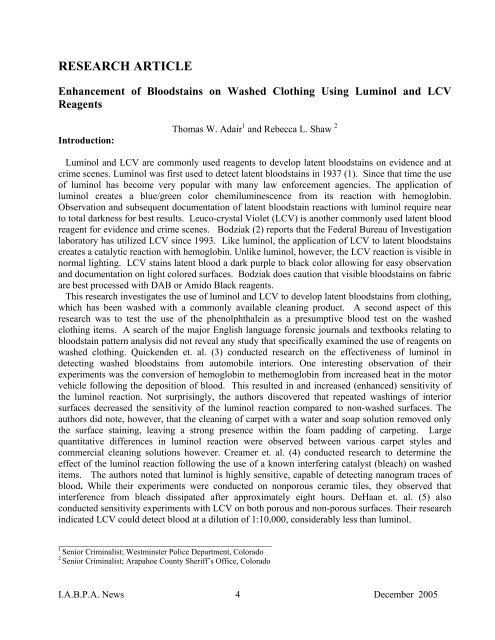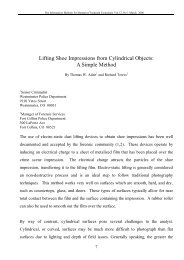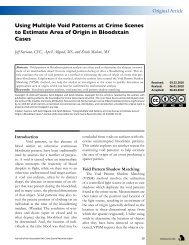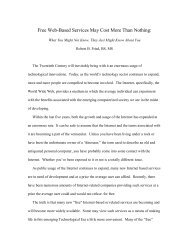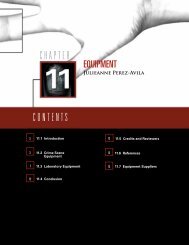Enhancement of Bloodstains on Washed Clothing Using Luminol ...
Enhancement of Bloodstains on Washed Clothing Using Luminol ...
Enhancement of Bloodstains on Washed Clothing Using Luminol ...
Create successful ePaper yourself
Turn your PDF publications into a flip-book with our unique Google optimized e-Paper software.
RESEARCH ARTICLE<br />
<str<strong>on</strong>g>Enhancement</str<strong>on</strong>g> <str<strong>on</strong>g>of</str<strong>on</strong>g> <str<strong>on</strong>g>Bloodstains</str<strong>on</strong>g> <strong>on</strong> <strong>Washed</strong> <strong>Clothing</strong> <strong>Using</strong> <strong>Luminol</strong> and LCV<br />
Reagents<br />
Introducti<strong>on</strong>:<br />
Thomas W. Adair 1 and Rebecca L. Shaw 2<br />
<strong>Luminol</strong> and LCV are comm<strong>on</strong>ly used reagents to develop latent bloodstains <strong>on</strong> evidence and at<br />
crime scenes. <strong>Luminol</strong> was first used to detect latent bloodstains in 1937 (1). Since that time the use<br />
<str<strong>on</strong>g>of</str<strong>on</strong>g> luminol has become very popular with many law enforcement agencies. The applicati<strong>on</strong> <str<strong>on</strong>g>of</str<strong>on</strong>g><br />
luminol creates a blue/green color chemiluminescence from its reacti<strong>on</strong> with hemoglobin.<br />
Observati<strong>on</strong> and subsequent documentati<strong>on</strong> <str<strong>on</strong>g>of</str<strong>on</strong>g> latent bloodstain reacti<strong>on</strong>s with luminol require near<br />
to total darkness for best results. Leuco-crystal Violet (LCV) is another comm<strong>on</strong>ly used latent blood<br />
reagent for evidence and crime scenes. Bodziak (2) reports that the Federal Bureau <str<strong>on</strong>g>of</str<strong>on</strong>g> Investigati<strong>on</strong><br />
laboratory has utilized LCV since 1993. Like luminol, the applicati<strong>on</strong> <str<strong>on</strong>g>of</str<strong>on</strong>g> LCV to latent bloodstains<br />
creates a catalytic reacti<strong>on</strong> with hemoglobin. Unlike luminol, however, the LCV reacti<strong>on</strong> is visible in<br />
normal lighting. LCV stains latent blood a dark purple to black color allowing for easy observati<strong>on</strong><br />
and documentati<strong>on</strong> <strong>on</strong> light colored surfaces. Bodziak does cauti<strong>on</strong> that visible bloodstains <strong>on</strong> fabric<br />
are best processed with DAB or Amido Black reagents.<br />
This research investigates the use <str<strong>on</strong>g>of</str<strong>on</strong>g> luminol and LCV to develop latent bloodstains from clothing,<br />
which has been washed with a comm<strong>on</strong>ly available cleaning product. A sec<strong>on</strong>d aspect <str<strong>on</strong>g>of</str<strong>on</strong>g> this<br />
research was to test the use <str<strong>on</strong>g>of</str<strong>on</strong>g> the phenolphthalein as a presumptive blood test <strong>on</strong> the washed<br />
clothing items. A search <str<strong>on</strong>g>of</str<strong>on</strong>g> the major English language forensic journals and textbooks relating to<br />
bloodstain pattern analysis did not reveal any study that specifically examined the use <str<strong>on</strong>g>of</str<strong>on</strong>g> reagents <strong>on</strong><br />
washed clothing. Quickenden et. al. (3) c<strong>on</strong>ducted research <strong>on</strong> the effectiveness <str<strong>on</strong>g>of</str<strong>on</strong>g> luminol in<br />
detecting washed bloodstains from automobile interiors. One interesting observati<strong>on</strong> <str<strong>on</strong>g>of</str<strong>on</strong>g> their<br />
experiments was the c<strong>on</strong>versi<strong>on</strong> <str<strong>on</strong>g>of</str<strong>on</strong>g> hemoglobin to methemoglobin from increased heat in the motor<br />
vehicle following the depositi<strong>on</strong> <str<strong>on</strong>g>of</str<strong>on</strong>g> blood. This resulted in and increased (enhanced) sensitivity <str<strong>on</strong>g>of</str<strong>on</strong>g><br />
the luminol reacti<strong>on</strong>. Not surprisingly, the authors discovered that repeated washings <str<strong>on</strong>g>of</str<strong>on</strong>g> interior<br />
surfaces decreased the sensitivity <str<strong>on</strong>g>of</str<strong>on</strong>g> the luminol reacti<strong>on</strong> compared to n<strong>on</strong>-washed surfaces. The<br />
authors did note, however, that the cleaning <str<strong>on</strong>g>of</str<strong>on</strong>g> carpet with a water and soap soluti<strong>on</strong> removed <strong>on</strong>ly<br />
the surface staining, leaving a str<strong>on</strong>g presence within the foam padding <str<strong>on</strong>g>of</str<strong>on</strong>g> carpeting. Large<br />
quantitative differences in luminol reacti<strong>on</strong> were observed between various carpet styles and<br />
commercial cleaning soluti<strong>on</strong>s however. Creamer et. al. (4) c<strong>on</strong>ducted research to determine the<br />
effect <str<strong>on</strong>g>of</str<strong>on</strong>g> the luminol reacti<strong>on</strong> following the use <str<strong>on</strong>g>of</str<strong>on</strong>g> a known interfering catalyst (bleach) <strong>on</strong> washed<br />
items. The authors noted that luminol is highly sensitive, capable <str<strong>on</strong>g>of</str<strong>on</strong>g> detecting nanogram traces <str<strong>on</strong>g>of</str<strong>on</strong>g><br />
blood. While their experiments were c<strong>on</strong>ducted <strong>on</strong> n<strong>on</strong>porous ceramic tiles, they observed that<br />
interference from bleach dissipated after approximately eight hours. DeHaan et. al. (5) also<br />
c<strong>on</strong>ducted sensitivity experiments with LCV <strong>on</strong> both porous and n<strong>on</strong>-porous surfaces. Their research<br />
indicated LCV could detect blood at a diluti<strong>on</strong> <str<strong>on</strong>g>of</str<strong>on</strong>g> 1:10,000, c<strong>on</strong>siderably less than luminol.<br />
____________________________________________<br />
1 Senior Criminalist; Westminster Police Department, Colorado<br />
2 Senior Criminalist; Arapahoe County Sheriff’s Office, Colorado<br />
I.A.B.P.A. News 4 December 2005
Gifford (6) reported a case study in which bloodstains were found <strong>on</strong> the clothing <str<strong>on</strong>g>of</str<strong>on</strong>g> a male victim<br />
who had been discovered in water six days following his death. The author c<strong>on</strong>ducted experiments<br />
<strong>on</strong> bloodstained clothing in moving and stagnant water and found that bloodstains would not remain<br />
<strong>on</strong> the clothing after 30 minutes in moving water and not more than three hours in stagnant water.<br />
Certainly the acti<strong>on</strong> <str<strong>on</strong>g>of</str<strong>on</strong>g> the washing machine will dissipate blood at an even faster rate. Following<br />
his experiments, Gifford c<strong>on</strong>cluded that diffused blood still visible <strong>on</strong> the victim’s wet or washed<br />
clothing was deposited after the clothing was removed from the water source (in that case a stream).<br />
Materials and Testing Methods:<br />
All experiments were c<strong>on</strong>ducted at the Arapahoe County Sheriff’s Office Crime Laboratory in<br />
Centennial, Colorado in July <str<strong>on</strong>g>of</str<strong>on</strong>g> 2005. Whole horse blood obtained from a local veterinarian hospital<br />
was used for all experiments. Quickenden and Cooper (7) experimented with the luminol reacti<strong>on</strong><br />
using both human and bovine hemoglobin and found no significant difference in luminol reacti<strong>on</strong>s.<br />
Ten white colored Haynes brand “signature collecti<strong>on</strong>” 100% cott<strong>on</strong> undershirts were used for these<br />
experiments. The shirts had been worn for approximately 6-8 m<strong>on</strong>ths prior to experimentati<strong>on</strong> but<br />
had not previously been stained with blood. There was no visible discolorati<strong>on</strong> or staining in the<br />
testing areas prior to the experiments. An eleventh shirt <str<strong>on</strong>g>of</str<strong>on</strong>g> the same c<strong>on</strong>diti<strong>on</strong> was used as a c<strong>on</strong>trol.<br />
The shirts were labeled #1-11 near the neckline with a black Sharpie brand marker (designati<strong>on</strong>s “B”<br />
and “F” for back and fr<strong>on</strong>t). Three different types <str<strong>on</strong>g>of</str<strong>on</strong>g> bloodstain patterns were produced <strong>on</strong> both the<br />
fr<strong>on</strong>t and back <str<strong>on</strong>g>of</str<strong>on</strong>g> each shirt (Figure 1).<br />
Figure 1. Overall view <str<strong>on</strong>g>of</str<strong>on</strong>g> fr<strong>on</strong>t <str<strong>on</strong>g>of</str<strong>on</strong>g> shirt # 5 with three Figure 2. Close view <str<strong>on</strong>g>of</str<strong>on</strong>g> shoe impressi<strong>on</strong> in blood<br />
bloodstain pattern locati<strong>on</strong>s. <strong>on</strong> fr<strong>on</strong>t <str<strong>on</strong>g>of</str<strong>on</strong>g> shirt.<br />
I.A.B.P.A. News 5 December 2005
Footwear impressi<strong>on</strong>s were produced by coating the outsole with a thin layer <str<strong>on</strong>g>of</str<strong>on</strong>g> blood, stepping <strong>on</strong><br />
butcher paper to remove excess blood, and then stomping <strong>on</strong> the shirt (Figure 2). The projected<br />
bloodstain pattern (Figure 3) was created by forcing blood through a syringe <strong>on</strong>to the shirt. This<br />
created larger sized bloodstains with spinous processes. Misting bloodstain patterns were created by<br />
spraying the liquid blood through an aerosol sprayer (Figure 4). This created a very fine misting <str<strong>on</strong>g>of</str<strong>on</strong>g><br />
blood characterized by a blood droplet diameter <str<strong>on</strong>g>of</str<strong>on</strong>g> less than 1mm. Paper inserts were used to prevent<br />
soak through from <strong>on</strong>e side <str<strong>on</strong>g>of</str<strong>on</strong>g> the shirt to the other. The shirts were allowed to dry for <strong>on</strong>e hour prior<br />
to washing. Washing and drying were d<strong>on</strong>e in stackable Frigidaire “Gallery” model units. Tide<br />
liquid laundry detergent with color safe bleach alternative was used for all washings. No other items<br />
were washed with the test shirts.<br />
Figure 3. Close view <str<strong>on</strong>g>of</str<strong>on</strong>g> projected bloodstain pattern <strong>on</strong> Figure 4. Close view <str<strong>on</strong>g>of</str<strong>on</strong>g> misted bloodstain pattern <strong>on</strong><br />
fr<strong>on</strong>t <str<strong>on</strong>g>of</str<strong>on</strong>g> shirt. fr<strong>on</strong>t <str<strong>on</strong>g>of</str<strong>on</strong>g> shirt.<br />
Shirts #1-5 were washed from <strong>on</strong>e to five times with no drying cycles. Shirt #1 was washed a<br />
single time, shirt #2 two times, and so <strong>on</strong>. A new applicati<strong>on</strong> <str<strong>on</strong>g>of</str<strong>on</strong>g> detergent was used for each wash<br />
cycle. Shirts #6-10 were washed in the same manner with a drying cycle <str<strong>on</strong>g>of</str<strong>on</strong>g> approximately <strong>on</strong>e hour<br />
between each wash cycle. Shirt #6 had <strong>on</strong>e wash and dry cycle, shirt #7 had two wash and dry<br />
cycles, and so <strong>on</strong>. Shirt #5 had five c<strong>on</strong>secutive washing cycles with no drying <str<strong>on</strong>g>of</str<strong>on</strong>g> the shirt, while<br />
shirt #10 had a total <str<strong>on</strong>g>of</str<strong>on</strong>g> five alternating washing and drying cycles. The c<strong>on</strong>trol shirt was subjected<br />
to a single wash cycle with detergent. After the final designated cycle each shirt was photographed<br />
in normal lighting. Each shirt showed a significant diffusi<strong>on</strong> <str<strong>on</strong>g>of</str<strong>on</strong>g> blood staining over a large area that<br />
had a dull green colored appearance (Figure 5). A small sample <str<strong>on</strong>g>of</str<strong>on</strong>g> the green colored stain area<br />
(approx. 1cm 2 ) was cut out from the sleeve <str<strong>on</strong>g>of</str<strong>on</strong>g> each shirt and tested with the phenolphthalein reagent.<br />
Samples were taken from the sleeve band area from each shirt where no direct bloodstaining had<br />
occurred while setting up the experiments. The shirts were then cut al<strong>on</strong>g their outer seams to<br />
I.A.B.P.A. News 6 December 2005
separate the fr<strong>on</strong>t and back halves <str<strong>on</strong>g>of</str<strong>on</strong>g> the shirt. One half <str<strong>on</strong>g>of</str<strong>on</strong>g> the shirt was then processed with the<br />
luminol reagent while the other was processed with LCV. All photographs were taken with both a<br />
Nik<strong>on</strong> D100 and D2X Digital cameras. Good quality luminol exposures were shot at F3.5 between<br />
15-25 sec.<br />
Discussi<strong>on</strong>:<br />
Figure 5. Overall view <str<strong>on</strong>g>of</str<strong>on</strong>g> shirt # 5 showing dull green appearance after washing.<br />
Immediate str<strong>on</strong>g and positive phenolphthalein results were obtained <strong>on</strong> each shirt tested.<br />
Applicati<strong>on</strong> <str<strong>on</strong>g>of</str<strong>on</strong>g> the phenolphthalein reagent, and subsequent hydrogen peroxide, were d<strong>on</strong>e directly<br />
<strong>on</strong> the fabric. This resulted in a “ring” appearance <str<strong>on</strong>g>of</str<strong>on</strong>g> the color reacti<strong>on</strong>. In additi<strong>on</strong>, similar sized<br />
areas were tested following the applicati<strong>on</strong> <str<strong>on</strong>g>of</str<strong>on</strong>g> both luminol and LCV. Positive phenolphthalein<br />
reacti<strong>on</strong>s were achieved with both luminol and LCV treated shirts. All reagent and phenolphthalein<br />
testing <strong>on</strong> the c<strong>on</strong>trol shirt was negative. LCV reacti<strong>on</strong>s <strong>on</strong> all shirts were immediate and<br />
pr<strong>on</strong>ounced. The reacti<strong>on</strong> area appeared uniform and homogenous with no discernable or<br />
meaningful pattern recogniti<strong>on</strong> possible (Figure 6). Previous studies (8) have shown LCV to be a<br />
reliable latent blood reagent <strong>on</strong> unwashed clothing. The luminol reagent produced much better<br />
results <strong>on</strong> the tested clothing. Figures 7 and 8 show the luminol results <strong>on</strong> shirts #5 and #10. These<br />
shirts represent the materials that should show the lowest degree <str<strong>on</strong>g>of</str<strong>on</strong>g> luminol sensitivity due to their<br />
repeated cleanings. The projected bloodstain patterns were clearly visible and discernable in all ten<br />
I.A.B.P.A. News 7 December 2005
shirts tested (Figures 7-9). C<strong>on</strong>versely, the misting pattern was not discernable <strong>on</strong> any <str<strong>on</strong>g>of</str<strong>on</strong>g> the ten<br />
tested shirts. The footwear impressi<strong>on</strong>s were visible with luminol <strong>on</strong> shirts numbers # 2, #3, and #4<br />
(Figure 9), and in plain view <strong>on</strong> shirts #7 and #8. The inc<strong>on</strong>sistency regarding the presence or<br />
absence <str<strong>on</strong>g>of</str<strong>on</strong>g> footwear impressi<strong>on</strong>s may be due to varied degrees <str<strong>on</strong>g>of</str<strong>on</strong>g> blood volume and stomping<br />
pressure <strong>on</strong> the tested shirts. N<strong>on</strong>e <str<strong>on</strong>g>of</str<strong>on</strong>g> the footwear impressi<strong>on</strong>s c<strong>on</strong>tained sufficient detail for an<br />
identificati<strong>on</strong> with the known shoe, however, the physical size and design <str<strong>on</strong>g>of</str<strong>on</strong>g> the footwear was<br />
discernable in most cases.<br />
The greenish colored bloodstain patterns <strong>on</strong> the shirts following the first wash cycle were likely the<br />
result <str<strong>on</strong>g>of</str<strong>on</strong>g> the bloodstains not being completely dried prior to washing. This staining presents several<br />
interesting challenges for the bloodstain pattern analyst. First and foremost, the visible and reagent<br />
staining bore little overall resemblance to the initial bloodstaining. While the projected and transfer<br />
(footwear) patterns could be seen in most cases, they were <str<strong>on</strong>g>of</str<strong>on</strong>g>ten intermingled with the “background”<br />
staining. Analysts who interpreted these diffused stains to be the result <str<strong>on</strong>g>of</str<strong>on</strong>g> any acti<strong>on</strong> other than<br />
washing would be incorrect in their analysis (in this specific case at least). In a similar fashi<strong>on</strong>, the<br />
“background noise” created by this staining made identificati<strong>on</strong> <str<strong>on</strong>g>of</str<strong>on</strong>g> the initial stain areas more<br />
difficult using visible light. In the case <str<strong>on</strong>g>of</str<strong>on</strong>g> the misted blood it is unclear to the authors if the staining<br />
was actually present, albeit masked, by the additi<strong>on</strong>al staining caused by the washing cycles, or if it<br />
was completely destroyed by the washing cycle(s). The areas <str<strong>on</strong>g>of</str<strong>on</strong>g> projected blood and several <str<strong>on</strong>g>of</str<strong>on</strong>g> the<br />
footwear impressi<strong>on</strong>s were visible, but it was impossible for us to determine c<strong>on</strong>clusively any<br />
sequence to the blood depositi<strong>on</strong> <strong>on</strong> the “background” and “foreground”.<br />
Figure 6. Overall view <str<strong>on</strong>g>of</str<strong>on</strong>g> shirt # 3 after LCV processing. Figure 7. Overall view <str<strong>on</strong>g>of</str<strong>on</strong>g> luminal reacti<strong>on</strong> <strong>on</strong> shirt # 5.<br />
I.A.B.P.A. News 8 December 2005
Figure 8. Overall view <str<strong>on</strong>g>of</str<strong>on</strong>g> luminol reacti<strong>on</strong> <strong>on</strong> shirt # 10. Figure 9. View <str<strong>on</strong>g>of</str<strong>on</strong>g> projected pattern and footwear<br />
impressi<strong>on</strong> <strong>on</strong> shirt # 3<br />
C<strong>on</strong>clusi<strong>on</strong>:<br />
Investigators may be presented with washed clothing that is believed to c<strong>on</strong>tain bloodstains from<br />
violent acts such as homicide, assault, or sexual assault. Suspects, their associates, or victims may<br />
wash clothing following bloodshed, thereby destroying blood evidence and complicate the<br />
rec<strong>on</strong>structi<strong>on</strong> process. Diluted bloodstains resulting from machine washing may not be visible<br />
especially <strong>on</strong> dark colored clothing. In such cases, the use <str<strong>on</strong>g>of</str<strong>on</strong>g> a chemical reagent may be the <strong>on</strong>ly<br />
acceptable method for developing latent bloodstains. Regardless <str<strong>on</strong>g>of</str<strong>on</strong>g> which reagent is used to<br />
visualize latent bloodstains, analysts should use cauti<strong>on</strong> when interpreting diffused or diluted<br />
bloodstain patterns occurring over a large area <str<strong>on</strong>g>of</str<strong>on</strong>g> the clothing in questi<strong>on</strong>. This level <str<strong>on</strong>g>of</str<strong>on</strong>g> saturati<strong>on</strong><br />
may be the result <str<strong>on</strong>g>of</str<strong>on</strong>g> the washing process and may not relate to any <strong>on</strong>e specific blood letting event.<br />
This research supports the use <str<strong>on</strong>g>of</str<strong>on</strong>g> luminol as an effective reagent to visualize latent bloodstain<br />
patterns <strong>on</strong> washed clothing. LCV, while an effective blood reagent <strong>on</strong> many washed and unwashed<br />
surfaces (pers<strong>on</strong>al observati<strong>on</strong>s <str<strong>on</strong>g>of</str<strong>on</strong>g> the senior author), did not yield acceptable results in this study.<br />
Analysts are cauti<strong>on</strong>ed in using LCV <strong>on</strong> washed clothing or other washed porous items.<br />
Furthermore, our research indicates that phenolphthalein will yield presumptively positive results <strong>on</strong><br />
washed clothing, even after applicati<strong>on</strong> <str<strong>on</strong>g>of</str<strong>on</strong>g> these two chemical reagents. Analysts are encouraged to<br />
report similar testing results to aid in defining the sensitivity and proper usage parameters <str<strong>on</strong>g>of</str<strong>on</strong>g> LCV<br />
and luminol <strong>on</strong> cleaned porous and n<strong>on</strong>-porous surfaces.<br />
I.A.B.P.A. News 9 December 2005
References:<br />
1. Specht, W. 1937. Die Chemiluminesenz des Hamins, ein Hilfsmittel zur Auffindung und Erkennung<br />
foensisch wichturger Blutspuren (The Chemiluminescense <str<strong>on</strong>g>of</str<strong>on</strong>g> Hemin as a means <str<strong>on</strong>g>of</str<strong>on</strong>g> finding and recognizing<br />
blood traces <str<strong>on</strong>g>of</str<strong>on</strong>g> forensic importance). Angew. Chem. 50:155-157.<br />
2. Bodziak, W.J. 1996. Use <str<strong>on</strong>g>of</str<strong>on</strong>g> leuco crystal violet to enhance shoe prints in blood. Foren. Sci. Int. 82:45-52.<br />
3. Quickenden, T.I., C.P. Ennis, and J.I. Creamer. 2004. The forensic use <str<strong>on</strong>g>of</str<strong>on</strong>g> luminol chemiluminescence to<br />
detect traces <str<strong>on</strong>g>of</str<strong>on</strong>g> blood inside motor vehicles. Luminescence 19:271-277.<br />
4. Creamer, J.I., T.I. Quickenden, L.B. Cricht<strong>on</strong>, P. Roberts<strong>on</strong>, and R.A. Ruhayel. 2005. Attempted cleaning<br />
<str<strong>on</strong>g>of</str<strong>on</strong>g> bloodstains and its effect <strong>on</strong> the forensic luminol test. Luminescence (in press).<br />
5. DeHaan, D.J., Clark, J.D., Spear, T.F., Oswalt, R., and Barney, S.S. Web Posting at www.latentprints.com/cac_blood.htm.<br />
6. Gifford, W.D., 1999. Bloodstain Survival in Water. IABPA News 15(2):1-6.<br />
7. T.I. Quikenden and P.D. Cooper. 2001. Increasing the specificity <str<strong>on</strong>g>of</str<strong>on</strong>g> the forensic luminol test for blood.<br />
Luminescence 16:251-253.<br />
8. Adair, T.W. 2005. Casting two-dimensi<strong>on</strong>al bloody shoe prints from c<strong>on</strong>crete, fabric, and human skin: a<br />
review <str<strong>on</strong>g>of</str<strong>on</strong>g> several methods with recommendati<strong>on</strong>s. IABPA News. March 2005:4-8.


